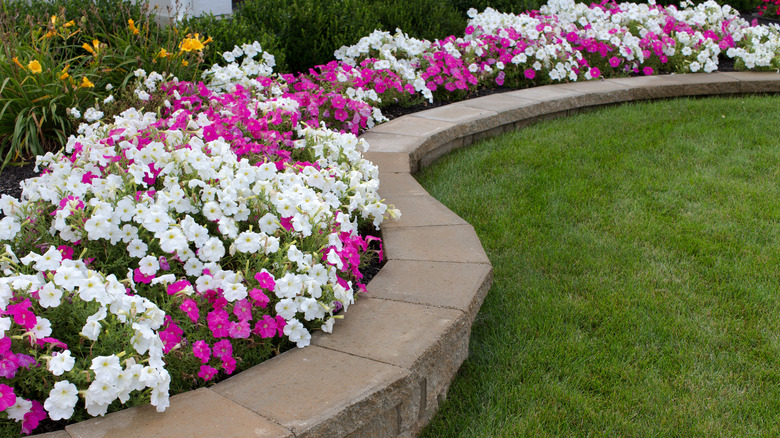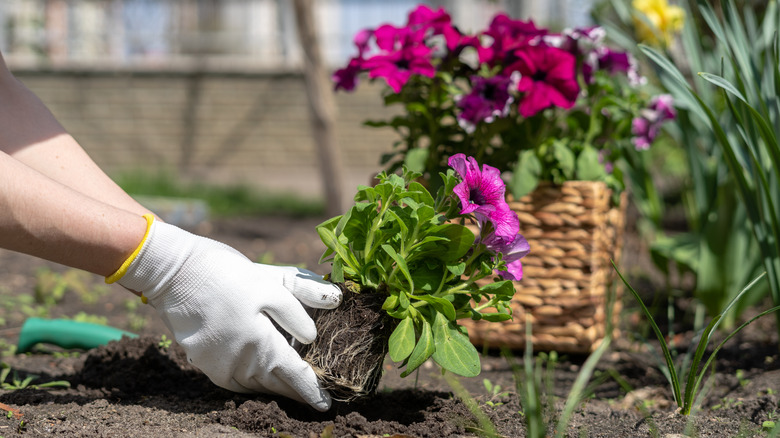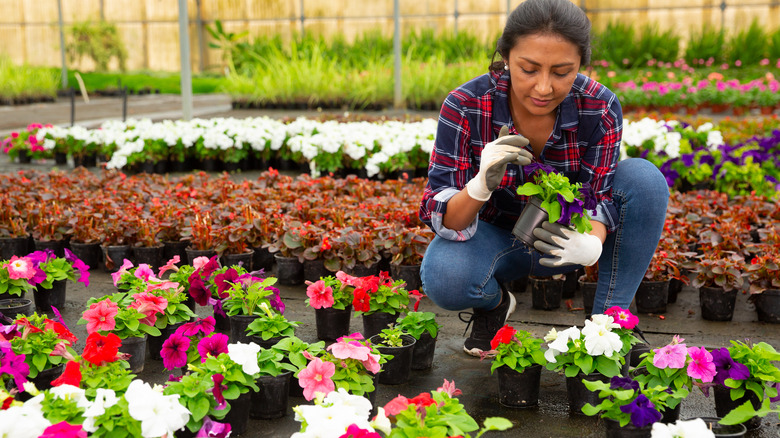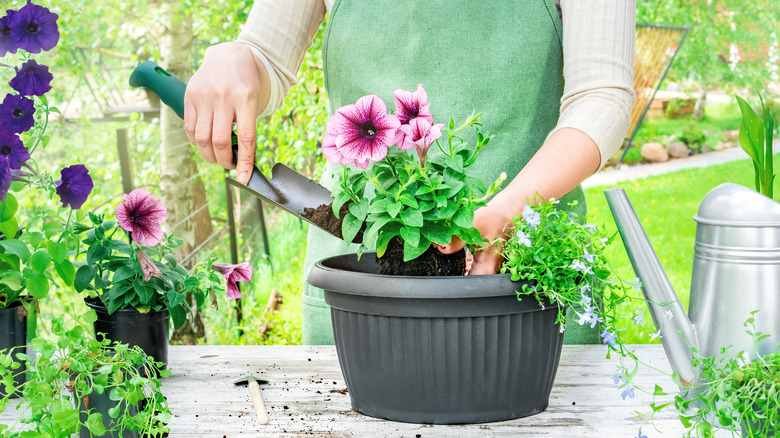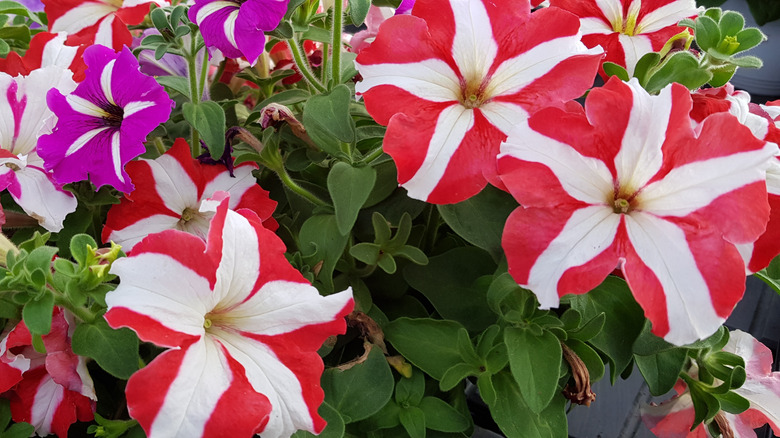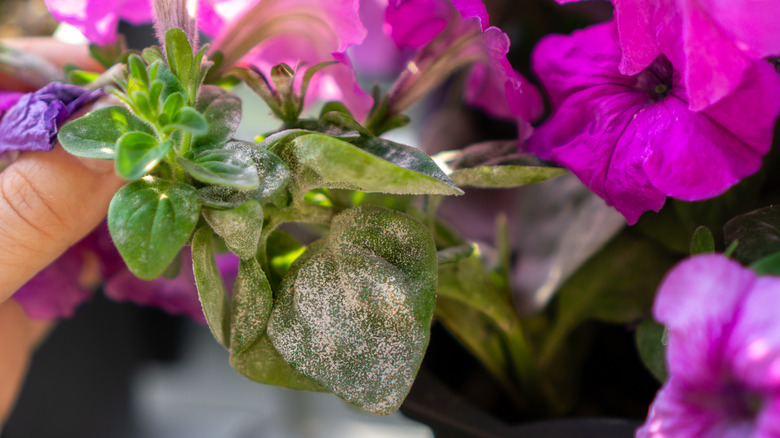Petunias: Everything You Need To Know Before Planting
Known for their colorful blooms, petunias (Petunia spp.) make some of the best annual flowers for your garden because they bloom fast and last all summer long. The trumpet-shaped blossoms come in just about every color imaginable, and the plants can grow up to 36 inches tall. In addition, they are versatile. According to The Spruce, they add gorgeous blooms to flower beds, edging, or containers. Wherever you decide to grow petunias, you won't be disappointed. They are a fan favorite because they are relatively easy to care for as long as they get enough water and live in soil that is not too soggy. This makes them a great pick for beginner gardeners.
Petunias thrive in hardiness zones 10 through 11. If you live in a climate where summers get extremely hot, you may not see as many blooms as you usually would because too much direct sun will hinder their growth. The good news is there are plenty of varieties to choose from.
How to grow petunias
When shopping for petunias to plant in your garden or a container, Farmers' Almanac recommends looking for short, dense ones that have not yet bloomed. If you want to grow them from seeds, plant them in indoor containers 8 to 10 weeks before the last frost date, only transferring seedlings into the ground when there is no threat of frost. When planting, space them about 1 foot apart. Do not bury the seeds too deep in the mix, as they need light to germinate. If you are growing petunias in a pot, almost any kind of potting soil will do, but to keep them happy, use a slightly acidic, light soil that drains well (via The Spruce).
While you don't have to remove dead blooms for new growth, it never hurts to do so. If you find the stems of your plants are too long, go ahead and prune them because doing so can result in a fuller plant with more blooms that last throughout the summer.
How to care for petunias
Petunias like a lot of sun and need at least six hours a day to thrive. In climates where the afternoon sun is scorching, plant them where they will be protected from the afternoon sun. As per The Spruce, they prefer low humidity and moderate temperatures around 75 degrees, but can tolerate cooler nights in the 40s.
Petunias are happiest when their soil is moist. While they don't like soil that is too dry, they also don't like it when the ground gets too soggy. Too much water might lead to root rot, and it could also lead to longer stems with fewer blossoms. The best way to water your pansies is to keep an eye on the soil while you figure out a watering routine that best suits them. Keep in mind that plants in containers need more water than plants in the ground, per Farmers' Almanac. As far as fertilizer goes, it's best to go with a balanced one. When planting, add some compost to the soil to encourage growth. Fertilize in July and every three weeks thereafter.
How to repot petunias
When moving petunia seedlings to a larger pot, be sure to transfer them to a well-draining container. Add some gravel or a piece of cloth to the bottom of the pot to prevent soil from escaping out of the holes. According to Smart Gardening Guide, as potted petunias grow over the summer, they may outgrow their containers and become root bound, so keep an eye out for roots that may be popping up over the soil line or trying to escape from the drainage holes.
If your foliage turns yellow or the plants don't appear to be thriving a few months after planting, take a look at the root system to ensure your plant does not need a bigger pot. Transferring them to a larger pot will give them the space they need to last all summer long (via SF Gate). When repotting plants, keep the stems covered at the same level as in the old pot.
Petunia varieties
With an abundance of pansy varieties to choose from, it might seem overwhelming to select ones for your garden. One thing to consider is where they will be. Trailing varieties work well in hanging baskets or along borders. If you want dramatic colors, try these:
- Black Velvet Petunias Petunia 'Balpevac' – The University of British Columbia notes these petunias are striking with dark violet petals that look black, hence their name.
- Petunia Bravo (Petunia × atkinsiana) – They offer bright shades of blue and lavender.
- Purple Night Skies (Petunia cultivars) – They are covered with various-sized dots to mimic stars in the night skies (via Garden Lovers Club).
The Spruce also recommends a few of the Petunia x hybrida varieties to make a statement:
- Mini Rose Blast Pink ((Petunia x hybrida 'Mini Rose Blast Pink') – These petunias have pink and purple blossoms that look similar to a tie-dye pattern.
- Purple Pirouette (Petunia x hybrida 'Purple Pirouette') – They have frilly white edges surrounding deep purple flowers.
- Potunia Plus Red (Petunia x hybrida 'Potunia Plus Red') – These petunias have eye-catching deep red blooms.
Troubleshooting
While petunias are known for being easy to care for, they do fall victim to some problems. If you notice the blooms or leaves are wilted, it could be a water issue. It could mean too much or too little water, and the only way to know which end of the spectrum your plant falls on is to keep a close eye on how moist the soil feels when you water it, per The Spruce. Fungal problems may occur if you live in a humid area or if water sits for a prolonged time on the blooms or leaves, according to Farmers Almanac.
Petunias can also harbor a few pests that can ruin your garden — namely aphids, slugs, and flea beetles. The good news is that you can remove most of these bugs with a good spray of water. If that doesn't take care of the infestation, you can always opt for an insecticide.
